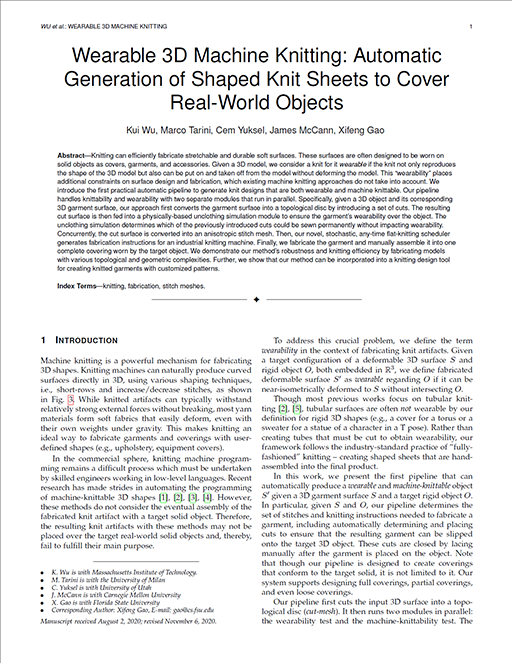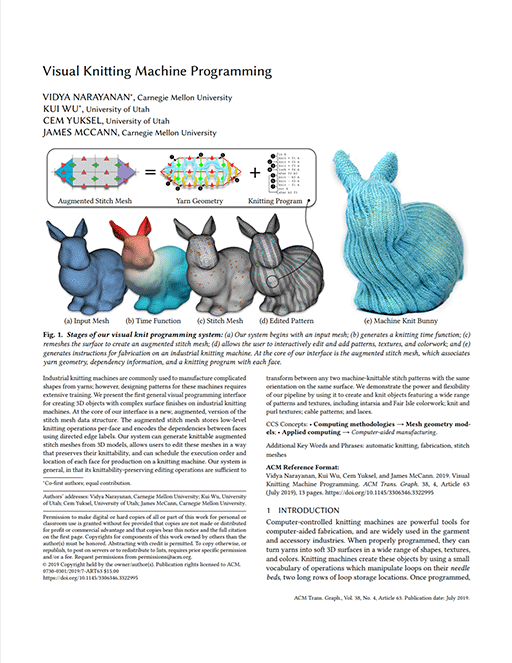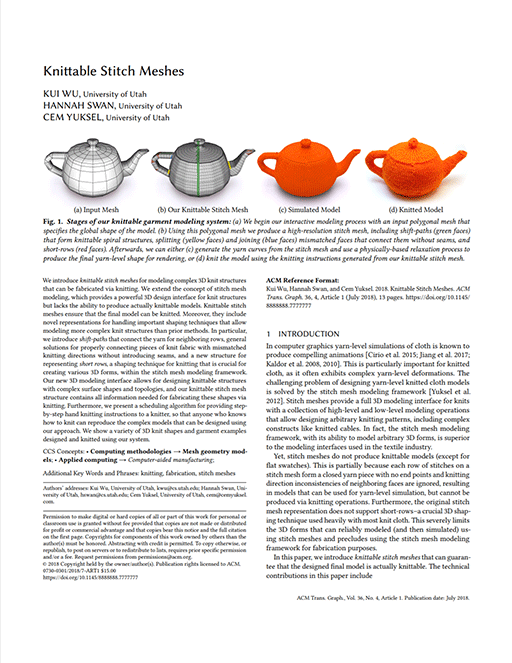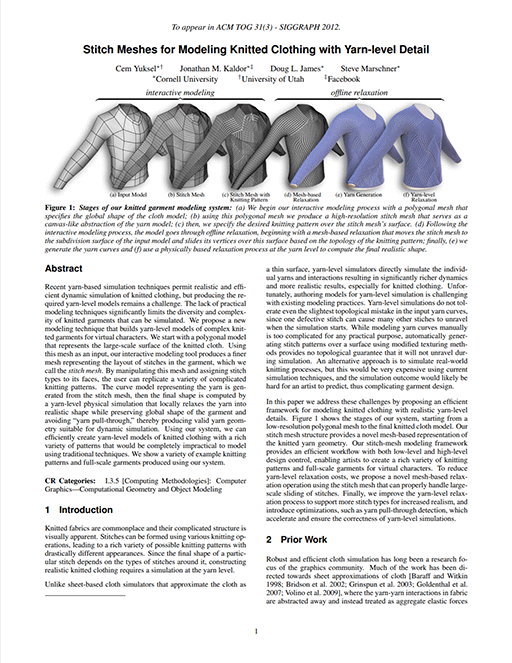Stitch Meshes

A knitted sweater dress for a sheep with Ridged Feather pattern, prepared using our knitted garment modeling system. The sheep character and the input mesh of the garment is modeled by Rune Spaans.
Abstract
Recent yarn-based simulation techniques permit realistic and efficient dynamic simulation of knitted clothing, but producing the required yarn-level models remains a challenge. The lack of practical modeling techniques significantly limits the diversity and complexity of knitted garments that can be simulated. We propose a new modeling technique that builds yarn-level models of complex knitted garments for virtual characters. We start with a polygonal model that represents the large-scale surface of the knitted cloth. Using this mesh as an input, our interactive modeling tool produces a finer mesh representing the layout of stitches in the garment, which we call the stitch mesh. By manipulating this mesh and assigning stitch types to its faces, the user can replicate a variety of complicated knitting patterns. The curve model representing the yarn is generated from the stitch mesh, then the final shape is computed by a yarn-level physical simulation that locally relaxes the yarn into realistic shape while preserving global shape of the garment and avoiding ``yarn pull-through,'' thereby producing valid yarn geometry suitable for dynamic simulation. Using our system, we can efficiently create yarn-level models of knitted clothing with a rich variety of patterns that would be completely impractical to model using traditional techniques. We show a variety of example knitting patterns and full-scale garments produced using our system.
See also the Project Page at Cornell University.
Images

Stages of our knitted garment modeling system: (a) We begin our interactive modeling process with a polygonal mesh that specifies the global shape of the cloth model; (b) using this polygonal mesh we produce a high-resolution \emph{stitch mesh} that serves as a canvas-like abstraction of the yarn model; (c) then, we specify the desired knitting pattern over the stitch mesh's surface. (d) Following the interactive modeling process, the model goes through offline relaxation, beginning with a mesh-based relaxation that moves the stitch mesh to the subdivision surface of the input model and slides its vertices over this surface based on the topology of the knitting pattern; finally, (e) we generate the yarn curves and (f) use a physically based relaxation process at the yarn level to compute the final realistic shape. The input mesh is modeled by Alexander Tomchuk.



Knitted dresses with two different stitch mesh layouts and knitting patterns, and knitted poncho with a Ribbing pattern, simulated on a mannequin. The mannequin and the input mesh of the dress is modeled by Alexander Tomchuk.

Knitted glove with a Ribbing pattern formed by alternating knit and purl stitches. The hand model and the input mesh is modeled by Alexander Tomchuk.

Knitted tea cozy with a Stockinette pattern formed by repeated knit stitches.
A knitted sweater for an alien character and the same sweater model with the Braid Cables pattern. The alien character is modeled by Christer Sveen and the input mesh of the sweater is modeled by Rune Spaans.

Comparisons to real knitted samples. The images at the top are photos of real-world knitted samples and the bottom ones are the results of our simulation. Considering that the results of knitting a particular pattern depend on the yarn and needles used, as well as the style of the individual knitter, these images show that we can qualitatively match the visual appearance of various patterns. Many thanks to Deborah Dawson for knitting the patterns 1, 2, 3, and 5, and Schoolhouse Press for granting us permission to use two photos (patterns 4 and 6) from A Fourth Treasury of Knitting Patterns by Barbara G. Walker.
Videos
Stitch Meshes for Modeling Knitted Clothing with Yarn-level Detail, SIGGRAPH 2012 paper video.Publications









